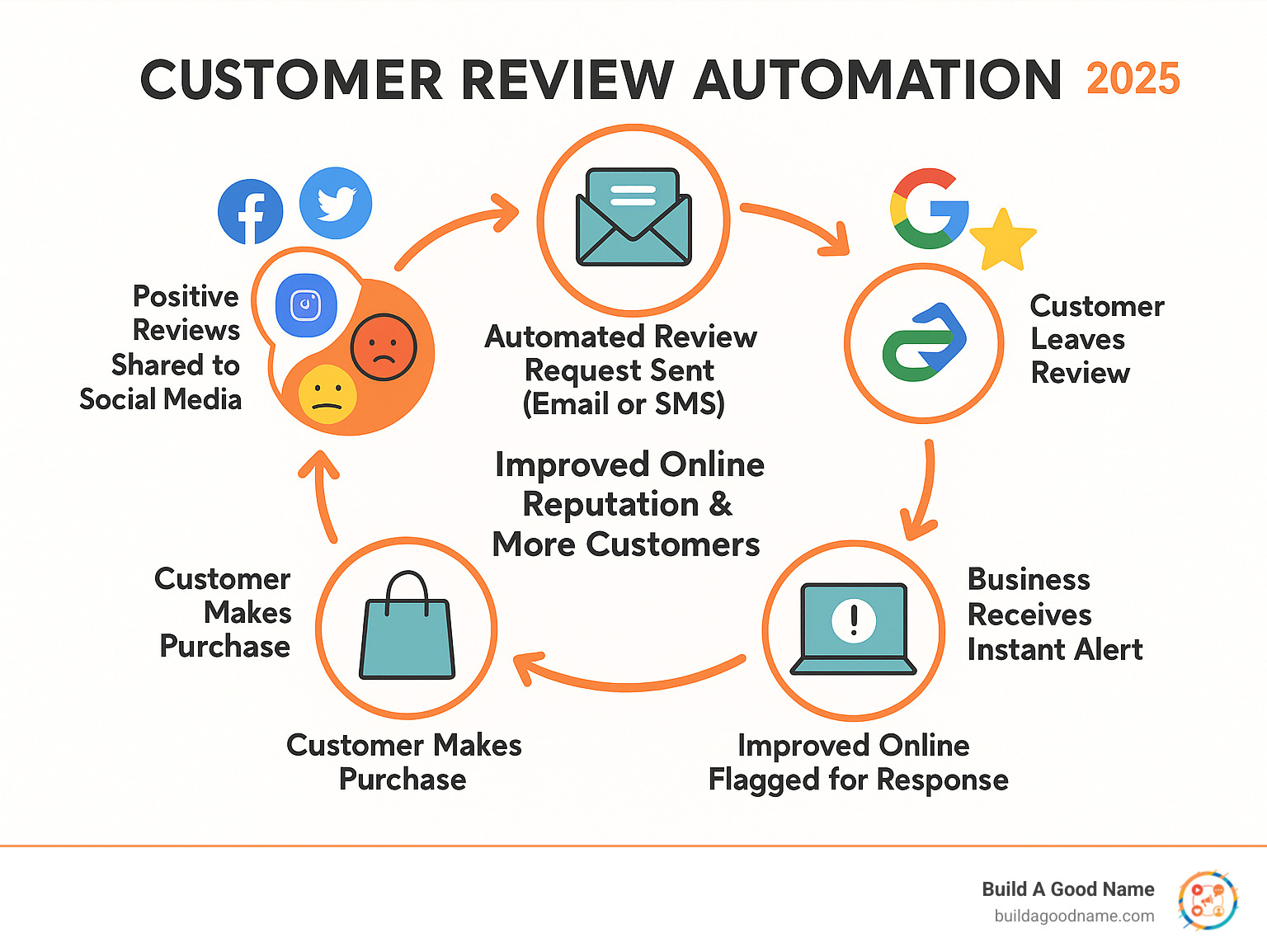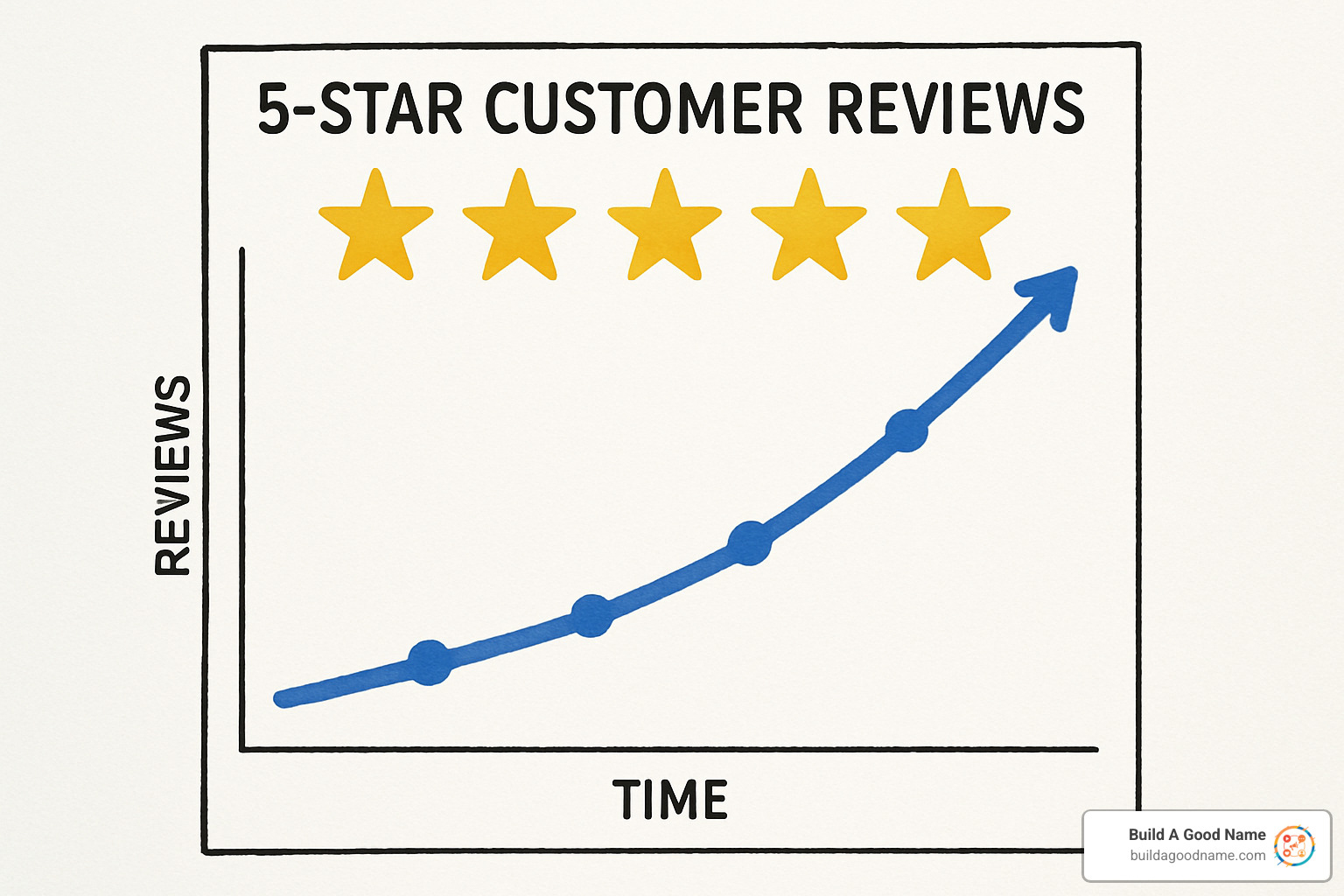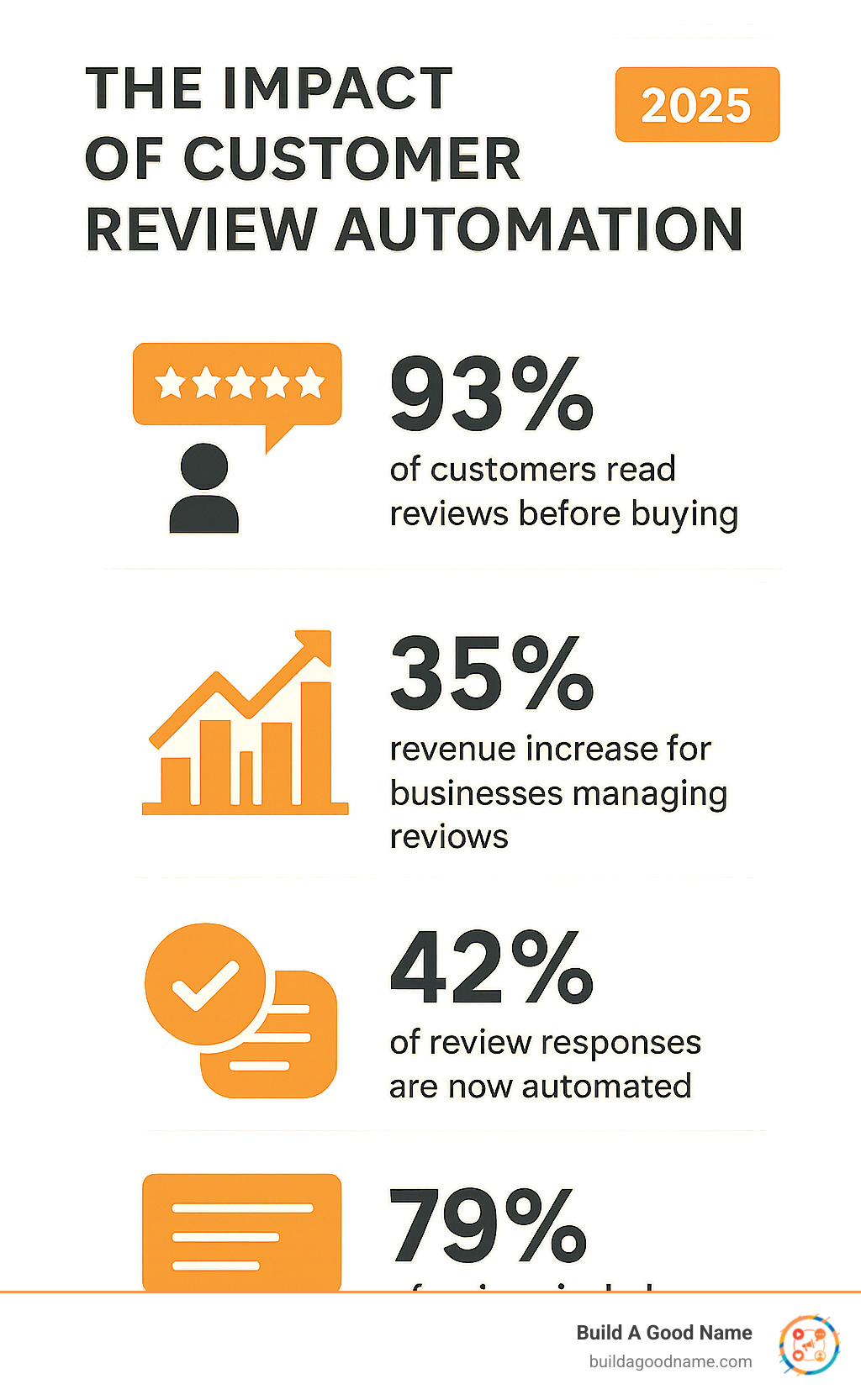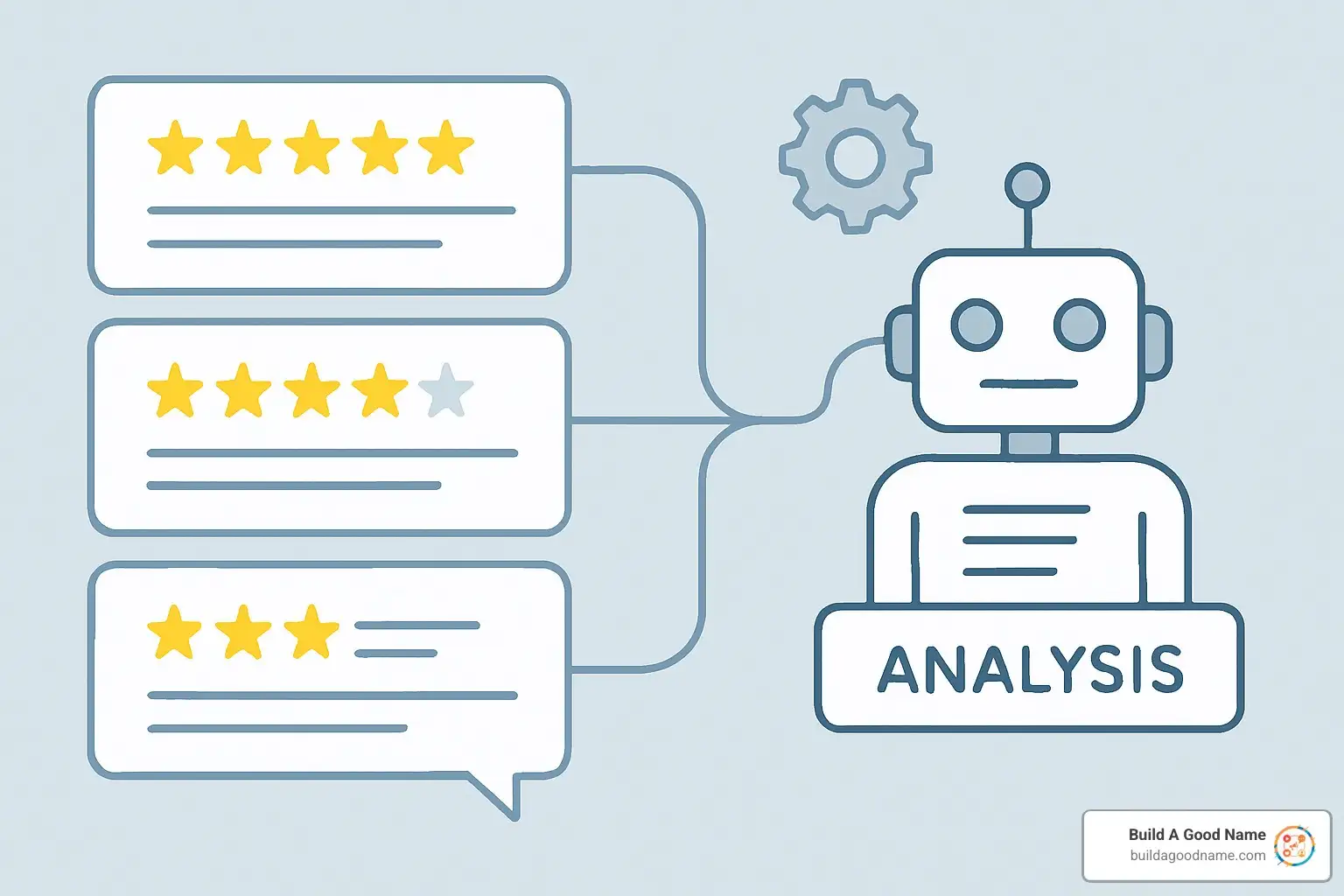Why Your Business Needs to Automate Reviews
Customer review automation uses software to automatically collect, monitor, and manage reviews across multiple platforms—without you spending hours every week doing it by hand.
What it does for you:
- Triggers review requests after a purchase or service
- Sends gentle reminders to customers who forget to leave feedback
- Monitors Google, Facebook, Yelp and dozens of other sites
- Alerts you instantly when a new review appears
- Helps you respond quickly with the right tone
- Analyzes feedback patterns so you can improve operations
Why this matters: studies show that 93 % of shoppers read reviews before buying, yet only about one in ten customers leave a review on their own. Ask at the right moment and that number jumps to roughly seven in ten.
Manually tracking each transaction, composing requests, and replying to feedback is exhausting. Automation reaches out right after a great experience, keeping your reputation growing while you focus on running your business.
Negative feedback hurts, too: almost 94 % of shoppers avoid a business with poor reviews. Companies that actively manage reviews report revenue lifts of up to 35 %—proof that reputation directly impacts the bottom line.

Common Customer review automation vocab:
- AI for business reviews
- Boost customer reviews
What is Customer Review Automation and How Does It Work?

Picture a tireless assistant who never forgets to ask happy customers for feedback. Customer review automation connects to your point-of-sale, booking, or CRM tools, watches for specific triggers—like a completed purchase—and instantly sends a friendly, personalized request for a review.
Research shows customers are far more likely to leave a review when asked soon after their experience, while the details are still fresh.
The Step-by-Step Automation Process
- Trigger setup – Define the events (sale closed, appointment finished, payment processed) that should launch a request.
- Customer segmentation – The system groups customers by interaction type, value, or history, then tailors messaging automatically.
- Automated outreach – Within hours or days, a branded email or SMS invites customers to share feedback.
- Direct review links – One-click links take them straight to your Google Business Profile, Facebook page, or other site—no hunting required.
- Feedback aggregation – All reviews flow into one dashboard so you can see the full picture at a glance.
- Real-time alerts – Instant notifications keep you in the loop, especially when negative feedback appears.
Specific Tasks You Can Automate
- Generating review requests and scheduled reminders
- Sharing positive reviews to social media
- Flagging negative reviews so a human can respond personally
- Automated review replies for routine five-star feedback
- Sentiment analysis to spot trends and operational issues
The Core Benefits of Customer Review Automation

Businesses that adopt customer review automation typically see review volume rise by more than 100 % in the first three months. More fresh reviews mean stronger social proof and higher visibility in local search results.
Other benefits include:
- Improved efficiency – reclaim hours each week by eliminating manual follow-ups
- Stronger online reputation – consistent, recent reviews build trust and drive new business
- Better local SEO – reviews are a top ranking factor for Google’s local pack
- Actionable customer insights – automatic sentiment analysis highlights what to improve
- Higher revenue – firms that manage reviews proactively often report sales lifts of up to 35 %
Boost Customer Satisfaction and Retention
Fast, thoughtful responses show customers their voices matter. Instant alerts let you address problems before they snowball, turning critics into loyal fans. Improving retention by just 5 % can raise profits 25-95 %, according to Bain research.
For hands-on response tips, see our guide on responding to Google reviews.
Save Time and Streamline Operations
A centralized dashboard brings every review from Google, Facebook, Yelp and industry-specific sites into one place. Automated tagging even tracks which team members get mentioned, making it easy to reward top performers and coach where needed.
With reputation tasks on autopilot, you stay focused on serving customers and growing the business.
Choosing the Right Platform and Avoiding Pitfalls

Selecting the right customer review automation platform is crucial for success. With so many options available, it’s important to focus on the features that will actually impact your business and avoid common pitfalls that can damage your reputation.
The key is finding a platform that balances automation with authenticity. While you want to streamline the process, you never want your customer interactions to feel robotic or impersonal. The best systems provide automation tools while preserving the human touch that builds genuine relationships.
Software Selection Criteria: Look for platforms that offer comprehensive features without overwhelming complexity. The system should be powerful enough to handle your needs but simple enough that you and your team can use it effectively.
Key Features: Essential features include multi-platform support, integration capabilities, analytics and reporting, ease of use, and customization options. We’ll dive deeper into these in the next section.
Ethical Considerations: This is perhaps the most important factor. The platform should help you collect authentic reviews from real customers, not manipulate or fake your online reputation.
Avoiding Drawbacks: Common pitfalls include over-automation, impersonal responses, and review gating (filtering out negative reviews before they go public). We’ll explore these concerns in detail.
Personalization: Even with automation, every customer interaction should feel personal and relevant. Look for systems that allow customization based on customer data and interaction history.
Authenticity: The goal is to make it easier for satisfied customers to leave reviews, not to artificially inflate your ratings. Authentic reviews are more valuable for both customers and search engines.
For more insights on selecting the right tools, read our comprehensive guide on review management software.
Key Features to Look for in Customer Review Automation Software
When evaluating customer review automation platforms, focus on these essential features:
Multi-platform Support: Your system should connect to all major review sites including Google, Facebook, Yelp, and industry-specific platforms. Look for software that monitors at least 200+ review sites to ensure comprehensive coverage.
Integrations: The platform should integrate seamlessly with your existing business tools. Common integrations include CRM systems (like Salesforce), POS systems (like Square), email marketing tools (like Mailchimp), and scheduling software. The more integrations available, the more automated your workflow can become.
Analytics and Reporting: Look for detailed analytics that show review trends, response rates, customer sentiment, and competitive benchmarking. The system should provide actionable insights, not just raw data.
Ease of Use: The interface should be intuitive enough that you and your team can use it without extensive training. Look for platforms with clean dashboards and straightforward navigation.
Customization and Branding: Your review requests should match your brand voice and visual identity. The system should allow you to customize message templates, timing, and even the appearance of review landing pages.
AI-Powered Features: Modern platforms leverage artificial intelligence for sentiment analysis, automated response generation, and trend identification. For more information about AI applications in review management, check out our article on AI for business reviews.
Mobile Accessibility: Since many business owners manage their operations on mobile devices, ensure the platform offers full mobile functionality.
Customer Support: Look for providers that offer comprehensive support, training resources, and responsive customer service. Implementation and ongoing support are crucial for success.
Potential Drawbacks and Ethical Considerations in Customer Review Automation
While customer review automation offers significant benefits, it’s important to be aware of potential pitfalls and ethical considerations:
Impersonal Responses: Over-reliance on automated responses can make your customer interactions feel robotic. While automation can handle routine tasks, important communications should always include a human touch.
Over-automation: Automating everything isn’t always better. Some interactions, particularly responses to negative reviews, require human judgment and empathy that automation cannot provide.
Review Gating: This practice involves filtering positive reviews to public sites while directing negative reviews to private feedback channels. Google explicitly bans this practice, and businesses caught review gating can have their reviews deleted.
FTC Guidelines: The Federal Trade Commission has specific guidelines about review collection and incentives. Make sure your automation practices comply with these regulations to avoid legal issues.
Maintaining Authenticity: The goal should always be to make it easier for genuine customers to leave honest reviews, not to manipulate your online reputation. Authentic reviews are more valuable for both customers and search engines.
Volume vs. Quality: While automation can increase review volume, focus on encouraging detailed, helpful reviews rather than just collecting star ratings.
For ethical approaches to managing difficult feedback, read our guide on how to filter negative reviews ethically.

Frequently Asked Questions about Review Automation
What types of businesses benefit most from review automation?
Customer review automation works best for businesses that have regular customer interactions and depend on their local reputation to attract new clients. The beauty of automation is that it helps any business that struggles with the common problem of satisfied customers simply forgetting to leave reviews.
Service-based businesses see incredible results from automation. Think about plumbers, electricians, HVAC technicians, and home repair services. These professionals often do amazing work, but customers get busy with their lives and forget to share their positive experiences online. Automation catches them while they’re still happy with the service.
Beauty and wellness businesses including salons, spas, massage therapists, and fitness centers have a natural advantage because customers visit regularly and form emotional connections with the service quality. When you automate review requests after each appointment, you’re capturing feedback when the experience is fresh in their minds.
Retail stores – both online and physical locations – can use automation to follow up after purchases, especially for higher-value items where customers have strong opinions about their shopping experience. The timing is perfect because customers have just completed their transaction and can easily remember the details.
Restaurants and food service businesses benefit tremendously because dining experiences are highly personal. People love sharing their restaurant experiences, but they often need that gentle reminder to actually write the review. Automation provides that perfect nudge.
Healthcare providers including dentists, veterinarians, and medical practices can use automation while maintaining patient privacy and compliance with healthcare regulations. These businesses often provide excellent care but struggle to get reviews because patients don’t naturally think to share medical experiences online.
Multi-location businesses might see the greatest benefit because automation ensures consistent review collection across all locations without requiring individual management at each site. Instead of hoping each location manager remembers to ask for reviews, the system handles everything automatically.
The truth is, any business with a Google Business Profile can benefit from automation. Google reviews are crucial for local search visibility and customer trust, regardless of your industry.
Is it against Google’s policy to automate review requests?
This is one of the most common concerns business owners have, and the answer is reassuring: automating review requests is perfectly fine according to Google’s policies. In fact, Google encourages businesses to ask customers for reviews as long as the process stays authentic and doesn’t try to manipulate results.
Here’s what Google allows: You can send automated emails or SMS messages asking customers to leave reviews. You can include direct links to your Google Business Profile or other review platforms to make it easy for customers. You can even send follow-up reminders to customers who haven’t responded to your initial request.
What Google prohibits is something called “review gating” – the sneaky practice of filtering customer feedback so that only positive reviews go to public sites while negative reviews get directed to private channels. This manipulation undermines the authenticity that makes reviews valuable in the first place.
The key is focusing on authenticity. Your automated messages should invite all customers to share their experiences, not just the ones you think will leave glowing reviews. Google’s algorithms are smart enough to detect manipulation, and businesses that try to game the system often face penalties.
Best practices include making your review requests feel personal and genuine. Explain why reviews matter to your business and how they help other customers make informed decisions. Always thank customers for their feedback, whether it’s positive or negative. This approach builds trust and encourages honest, helpful reviews.
How do you handle negative reviews with automation?
Handling negative reviews is where customer review automation requires the most finesse. While automation can help you respond quickly, negative reviews always need that human touch to turn a bad situation into a relationship-building opportunity.
Start with instant alerts. Set up your system to notify you immediately when negative reviews appear. Speed matters here – 45% of customers are more likely to visit your business when you respond to bad reviews, but only if your response feels genuine and helpful.
Never use fully automated replies for negative reviews. These situations require human empathy, understanding, and problem-solving skills that automation simply cannot provide. A robotic response to a genuine complaint will only make things worse.
Use templates as starting points instead. While you shouldn’t send automated responses to negative reviews, you can create templates that help you respond consistently while allowing for personalization. This ensures you address key points without sounding scripted.
Personalize every response by addressing the specific concerns mentioned in the review. Show that you’ve actually read and understood the customer’s experience. Generic responses feel dismissive and can damage your reputation further.
Offer concrete solutions, not just apologies. This might include refunds, service corrections, or process improvements. When potential customers see that you actively solve problems, they’re more likely to trust your business.
Take conversations offline by providing contact information and inviting the customer to discuss the issue privately. This shows other potential customers that you take concerns seriously and are committed to making things right.
For detailed strategies and real examples of effective responses, check out our guide on best responses to Google reviews. A well-handled negative review can actually strengthen your online reputation by demonstrating your commitment to customer satisfaction.
Conclusion: Accept Automation to Build a Better Reputation
Customer review automation isn’t just a nice-to-have feature anymore – it’s becoming essential for businesses that want to thrive in today’s digital marketplace. Think about it: when 93% of customers read reviews before buying, and businesses that actively manage their online reputation see up to 35% increases in revenue, can you really afford to leave your reputation to chance?
Throughout this guide, we’ve explored how automation transforms the way businesses handle customer feedback. The increased review volume you’ll see means more social proof for potential customers. The improved efficiency gives you back precious hours to focus on what you do best. Better customer relationships develop when you respond quickly and thoughtfully to feedback. And improved online reputation becomes the foundation for sustainable business growth.
The future of review management is already here, and it’s powered by artificial intelligence. AI-powered systems are helping businesses respond more effectively to customer feedback, analyze sentiment trends, and identify opportunities for improvement before small issues become big problems. The businesses that accept these technologies now will have a significant advantage over those still managing reviews manually.
The importance of a proactive strategy cannot be overstated. Waiting for customers to leave reviews organically is like hoping for rain in a drought – it might happen, but you can’t build a business on hope. Automation allows you to be proactive rather than reactive, reaching out to customers when their experience is fresh and their satisfaction is high.
At Build A Good Name, we understand that every business is unique. That’s why our AI-powered solutions adapt to your specific needs and industry requirements. Whether you’re a small local business just starting to build your online presence or a multi-location enterprise managing reputation across dozens of locations, automation can help you build the strong online reputation that drives growth and customer loyalty.
The next step is simple: start implementing customer review automation in your business today. The sooner you begin, the sooner you’ll see the benefits of increased reviews, improved customer relationships, and a stronger online reputation that attracts more customers.
Ready to see how AI can transform your review management strategy? Learn more about how AI can be used to respond to online customer reviews and find how our automated solutions can help your business thrive in the digital age.



